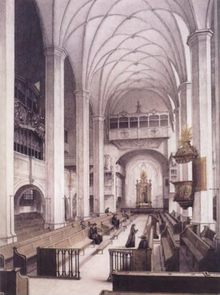| Wo gehest du hin? | |
|---|---|
BWV 166 | |
| Church cantata by J. S. Bach | |
 Thomaskirche, Leipzig, 1885 | |
| Occasion | Cantate Sunday |
| Bible text | John 16:5 |
| Chorale | |
| Performed | 7 May 1724: Leipzig |
| Movements | 6 |
| Vocal | SATB soloists and choir |
| Instrumental |
|
Wo gehest du hin? ("Where are you heading?",[1] literally: "Where do you go?"), BWV 166, is a church cantata by Johann Sebastian Bach for Cantate Sunday, the fourth Sunday after Easter. Bach composed the work as part of his first cantata cycle for Leipzig and first performed it on 7 May 1724.
The topic of the cantata is based on the Farewell Discourse from the Gospel of John, when Jesus announces a Comforter. Based on his question quoted from the narration, "Where do you go?", the cantata explores the direction in which life should go. Bach structured the work in six movements. The first movement is not the usual extended chorus, but an arioso for a bass setting a question from the gospel. It is followed by an aria for tenor, a hymn stanza for soprano, a recitative for bass and an aria for alto. The closing chorale is a four-part setting of the first stanza of the 1688 hymn "Wer weiß, wie nahe mir mein Ende". The text of the recitative and the arias was written by an unknown librettist. Bach scored the cantata for four voices and a Baroque instrumental ensemble of oboe, strings and continuo.